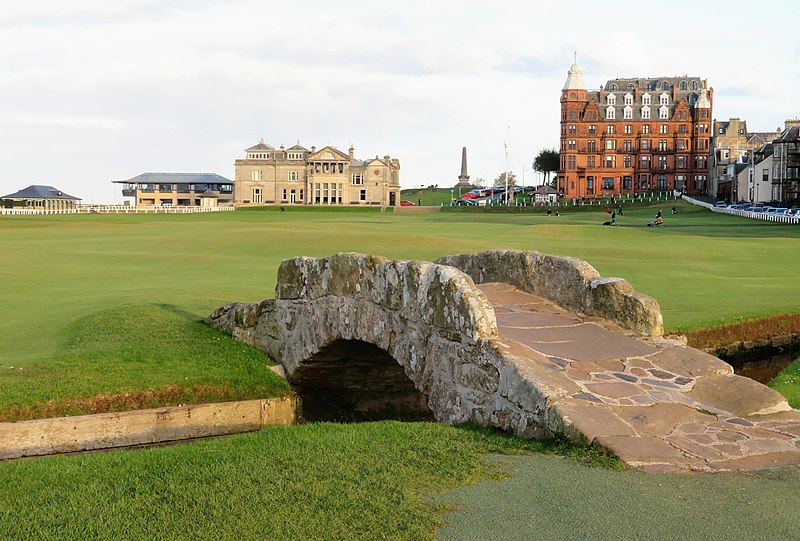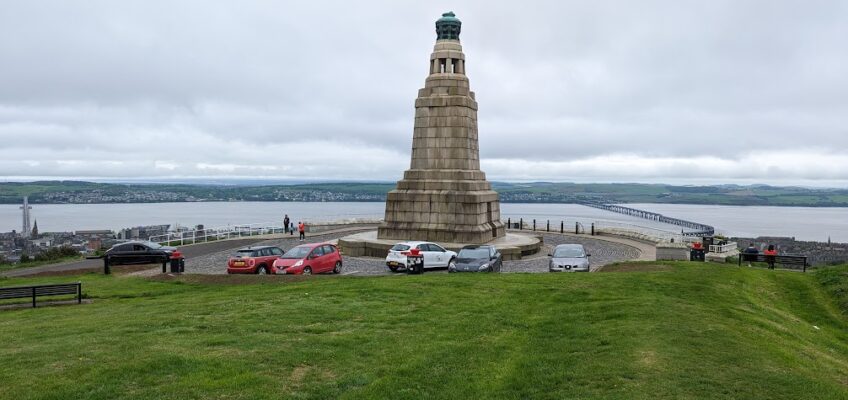From the rugged mountains and beautiful countryside where I spent the last two weeks, I’m ending my Scotland adventure in more urban settings. I spent the last three nights in Dundee, and now I’m on the train to Edinburgh. (I probably won’t finish this until I’m in my hotel in Edinburgh, maybe late tonight.)
I’m lucky to be able to take more than a full month to explore Scotland. I didn’t have to make a lot of compromises about where to go and where I’d have to skip. There are a few parts of the country I wish I could have seen, especially far north (Wick, Thurso, the Orkneys, and the Shetlands). But I ticked pretty much all my wishlist boxes on this trip.
I feel like I’ve had a good mix on this trip. I’ll be able to say with more certainty in another week, but I think this was a great itinerary. The perfect amount of civilization and a good lot of time away from civilization. Humans were responsible for some what I have seen, and nature also did a fair share.
This last portion of the trip, though, it’s back to the human-made stuff.
Dundee
Arrival day
I got to Dundee about 2pm on Saturday. My hotel is right on the River Tay across from the train station. It’s Premier Inn, the same chain I stayed at in Fort William. And the room is virtually identical: all the furniture, the bathroom, the layout of everything, right down to how the bed was made. It’s attached to the same restaurant (Beefeater) with the same breakfast buffet.
Check-in wasn’t until 3pm. A lot of the hotels I’ve stayed at on this trip don’t offer any early check-in at all. They won’t even look to see if your room is ready. If check-in is at 3pm (or later), that’s when they will check you in. At Premier Inn, they offer early check-in, for a £10 charge.
I said no thanks, but they were happy to hold my luggage until check-in, and I went to get lunch. I went for fish & chips at Tailend, a place that’s supposedly famous for their fish & chips. I’ve had fish & chips three or four times on this trip. These were not the best. Nor the second best, nor the third best. The fish wasn’t crispy and the chips were limp.
After lunch I got into my room. And I was happy to have the afternoon and evening to just relax and work on my previous blog post, which I hope you read.
By the time I was hungry again (because I did eat all the fish & chips even though they weren’t great), it was too late for a restaurant dinner, so I picked up a pre-made sandwich at a nearby convenience store.
That was my first day in Dundee.
Next day
I woke up to a foggy, drizzly day. And looking at the forecast for the next two days, it looked like mostly cloudy with periods of rain. So I had to figure out how to make the best use of my time, with indoor activities in the rain and outdoor activities between the drops. Today didn’t look like a good day for an excursion to St Andrews, but tomorrow might not be any better.
It seemed like a museum was a good way to start.
V&A Dundee
The V&A Dundee is one of the family of V&A museums. The original Victoria and Albert Museum in London opened in 1852 and is one of the world’s largest. The V&A Dundee opened in 2018. It is dedicated to Scottish design.
There were some interesting things on display, but overall, this is not my kind of museum. The best thing was the building itself.
Walk to Dundee Law
After I got out of the museum, the weather shows some signs of improvement, so I decided on a walk up to Dundee Law. (“Law” is the Scots Gaelic word for “hill.”)
According to walkhighlands, this walk “takes in the major attractions of the city centre before crossing town to climb up Dundee Law for its sensational views.” But first off, there aren’t a lot of major attractions in Dundee. There are a few attractions, but not a lot, and none I would describe as “major.” And second, as I walked, I found I had to detour off the walking route because I could see something that looked interesting down the block. These, too, weren’t major. Maybe they weren’t even attractions. But I enjoyed the walk, and I enjoyed seeing the minor attractions and other interesting things in Dundee.
This statue was unveiled in 2021.
Dundee Law
After a long and rather uninteresting uphill slog, I made it to the top of the hill. And the views were nice, but neither Dundee nor the surrounding area I could see from the top of Dundee Law were especially breathtaking. I’d call the views impressive, but not really sensational.
Verdant Works
On the way down from Dundee Law, I passed Verdant Works. Formerly a jute mill, it is now a museum dedicated to the story of jute in Dundee. So I decided to learn about jute.
All about jute
Jute is mostly made into burlap for coffee sacks and the like. It was also used as backing for linoleum and carpeting. There have been attempts to use it for other things, like clothing and upholstery, but these have been mostly unsuccessful.
In the 18th century Dundee was a center for the production of linen from flax. It was also a whaling center.
Jute is a fiber that comes from a plant that grows primarily in India. In the early 19th century a Dundee merchant named Thomas Neigh figured out that by soaking jute in whale oil, it could be spun into thread similarly to flax, but it was much less expensive. Starting in the 1840s jute replaced flax in the Dundee mills. Dundee quickly became the global center of the jute industry.
But it wasn’t long before financiers in India began importing spinning machinery from Dundee. And Dundee merchants realized they could save money by doing all their production in India, rather than shipping the raw jute to Scotland. By the end of the 19th century, jute industries in Bengal overtook Dundee’s jute trade.
This hurt the jute industry in Dundee, but it didn’t hurt the jute barons, as they had interests in Indian production. It did cause dire conditions of poverty, slums, and overcrowding in Dundee. It’s only in recent times that Dundee has begun to recover.
The last jute mill in Dundee closed in 1991. What really killed the jute industry was plastic. But as there is a move away from single-use plastics, there have been an increasing interest in jute production again. Dundee, however, will never see the benefit of that.
The museum
The museum was pretty interesting, and I did learn about jute, and about Dundee’s history as it relates to jute. They showed a lot of the machines and had displays depicting many aspects of the jute industry, from farming, harvesting, and shipping to production to the kinds of products they make with jute.
As I said, the museum was interesting, because I learned about something I was not familiar with. But I don’t particularly like to look at things like tools and artifacts and stuff like that. It doesn’t really get me excited about what I’m learning. I’d rather have seen some of the machines working to show how the process of creating products from jute happens.
The best part of the museum is that one of the docents actually worked in a jute factory (not Verdant Works, but a different one) in the 1960s, when she was 14 years old. She talked about her experience both then and since the mills closed. She was paid 1 shilling (5 pence) per day for working a ten-hour shift with a break for lunch. Since then she raised a family and lived in Dundee her entire life, never even traveling as far as London.
RRS Discovery
My final stop as I got back to the riverfront area was the RRS Discovery. This is the ship that took Robert L. Scott and Edward Shackleton to Antarctica in 1901. It also served for a number of other missions to Antarctica into the 1920s. It has been restored to its 1924 condition.
There’s a museum to go through before seeing the ship itself. The museum had a few interesting videos, but it mostly showed stuff (and as I said, I don’t particularly find looking at “stuff” very interesting).
The ship itself was cool to walk through, especially the living areas. There isn’t very much intact down in the engine level. (It was a sailing ship, but it had an auxiliary engine if needed in calm winds.)
St Andrews
The next day was my St Andrews day. It looked overcast, but I was hoping the sun would come out.
Buses to St Andrews run every ten minutes, and it’s about a half-hour ride. I got there and followed a walking tour from Rick Steves’ Scotland. First stop:
The Old Course
I don’t really care much about golf. I have occasionally watched it on TV, but never played and never had any interest in playing.
Still, when I stood at the edge of The Old Course at St Andrews, where golf was invented, I got a lump in my throat. Golf was first played here in the early 15th century. There’s so much history here. Thinking of that was really something.

The beach
Adjacent to the golf course is a famous beach.
Town and gown
There’s nothing really to say about this town. It is utterly charming, and it has a beautiful university campus. The photos tell the whole story. They also tell how it started raining.
Castle and Cathedral
Two remnants from long ago are the castle, built around 1200, and the cathedral, built in 1158.
Neither the castle nor the cathedral, interestingly, was destroyed. Rather, they both fell gradually into ruin. Weather, pilfering, and neglect led to their decay.
After I walked around for a while, the rain let up. And while I was having lunch, the sun came out. I walked back to the golf course to see it in the sunshine.
And then I got back on the bus and returned to Dundee.
Back in Dundee
Sunny Dundee awaited, and the one thing I still wanted to do was visit a museum.
The McManus
The McManus: Dundee’s Art Gallery & Museum is in a beautiful Gothic Revival building.
As the name suggests, it has art and other stuff. I was mostly interested in the art, but I did take a quick stroll through the other stuff.
There were a few good paintings, but overall, I found the collection underwhelming.
Haircut
All over Scotland I’ve seen Turkish barbers. I had a haircut in Turkey last year, and they do very good work. So I wanted to go to another Turkish barber.
Then I saw a Kurdish barbershop, and I thought, maybe that’s even better!
The did not disappoint, right down to the wax-covered cotton swabs stuck in my nose and then yanked out along with my nose hairs, and the fire waved over my ears to burn away the ear hairs.
As I predicted, it’s now late in the evening. I’m in my hotel room in Edinburgh. I’ve already seen and done a lot here, but I will have to get caught up another time.
Here are photos from Dundee. And here are photos from St Andrews.



Abby Bergman
Wonderful commentary and pictures!!
Lane
Thanks Abby. I’m glad you found it interesting.